By April Leigh
Nope, they aren't Bentleys. They're better than Bentleys. Take a trip with us behind the driver's seat during plow operator training on the west side of the state.
To do this, we'll need a bit of audience participation. Pretend you're a first-year maintenance worker this winter. You've completed all your training, got your commercial driver's license and know a ton about work zone safety and traffic control.
During the past few months, you've learned a lot about taking care of roads and bridges. But now the weather has turned and it's all about storms, snow and ice. You did well at the maintenance academy (yes, that's a thing), but it's not exactly what it will be in real life.
Then, like Rocky traveling to the snowcapped mountains of Russia before his title fight with Ivan Drago, you're sent to a little-known state highway outside of Hoquiam to learn from the best.
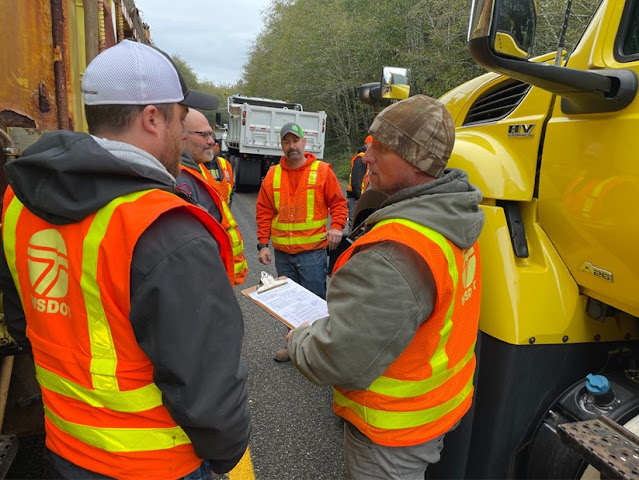 |
| For three days every fall, we close the SR 109 Spur in Hoquiam to train new maintenance workers with real trucks, on real roads, with real obstacles. |
Your trainers are maintenance workers with decades of experience. They're weathered, they've seen things and they've carved out three challenging plow truck obstacle courses for you.
Obstacle 1: Operate in snow and ice
You know there's a lot that goes into putting sand and salt on the road. You can't just drop it and go.
- You need to know how fast to drive and how much to put down.
- If you use too much, you'll need to refill the truck more often, making the task more expensive and time consuming.
- Too little won't get the job done.
- If you don't do it right, you can fling it to the side of the road where it won't help drivers.
Oh yeah, and while you're tracking all these things, you have to drive the truck – a multi-ton machine much larger than your average grocery getter. To make things even more challenging, new trucks and old trucks have different setups. Many trucks in our fleet vary in age.
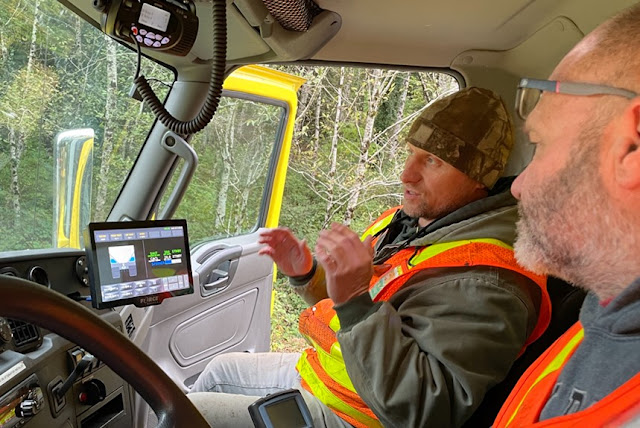 |
| Trainers teach new maintenance workers how to operate newer trucks with digital controls and older trucks with manual settings. |
It's a bit intimidating as your trainers take you on a tour of the equipment, but you muscle through. Eventually, they put you behind the wheel and give you the keys. They tell you to drive the narrow stretch of road while dropping sand and salt. You ask how many times, they give you a wry smile and answer like Mickey to Rocky: “As many times as it takes.”
After three passes, your trainers approve and you're on to the next course.
Obstacle 2: Move large debris off the road
As you approach, your trainers tell you winter in western Washington means more than snow and ice. Severe wind and rain bring downed trees and other debris that block roads.
 |
| Trainers use an excavator to place logs in the road for new maintenance workers to push with a plow truck. |
You watch as one trainer places logs in the road while another explains the size and types of debris you can expect to move with a plow truck after a storm. They teach you how to maneuver the plow on the front and how fast to go. You learn how to approach, when to turn around and what to do if the debris pile shifts while you're working. You're also taught how to spot electrical lines and who to contact if power is out in the area.
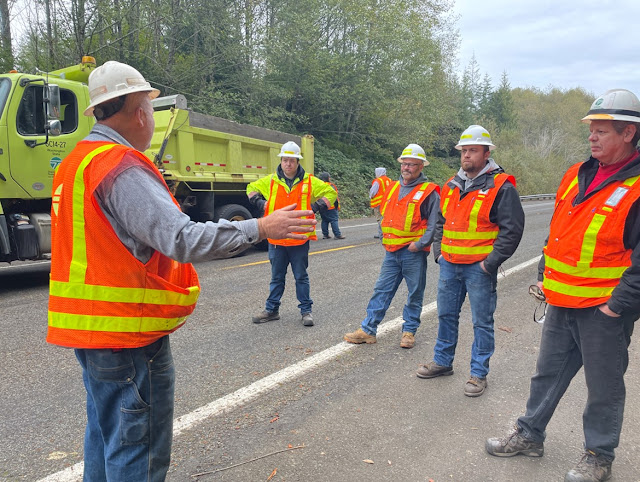 |
Trainers explain the dangers of downed power lines to new maintenance workers. |
After another thorough inspection of the truck, you get behind the wheel and are told to push several large logs off the road and into a nearby ditch. You know that if you push too fast or too hard you can damage the plow or the truck. Your first attempt does not go well. But after several tries you succeed.
Your trainer gives you a few more pointers about safety and the importance of using additional lights at night before sending you on to the next course.
Obstacle 3: Manage a simulated slide
You're feeling accomplished as you round the bend to your final challenge when you come upon a 5-foot-high pile of dirt in the road. Two tall skid loaders (pictured in the background below) with trainers sit on either side of the pile.
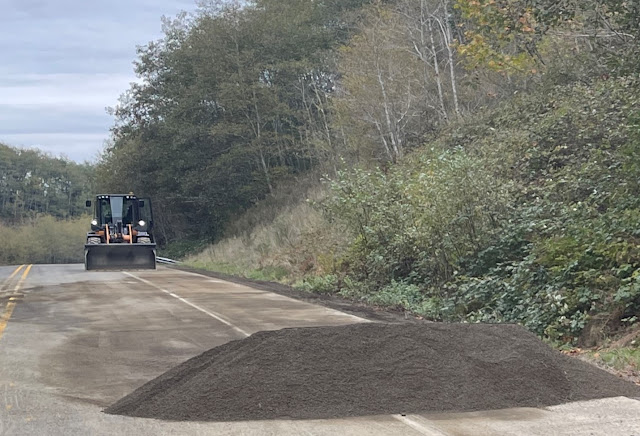 |
| A skid loader is a tall tractor-like piece of equipment used to pick up heavy materials like dirt and mud from roads. |
You increase your pace and get ready to learn all there is to know about driving a skid loader when another trainer stops you. You won't be learning a skid loader today. This is a simulation of a small slide and you will learn to move it off the road with a plow truck. But moving dirt and mud isn't the first step. You start with an inspection of the destroyed slope on the side of the road.
Your trainer explains how important it is for you to look at your surroundings first. Does it seem like the slope may slide again? If it's sagging at the edges or bulging in the center, you're told to close the road immediately and call for support.
Only after you're given an all clear can you work on the pile. But this is a slide, so you have to inspect that too. If there is fencing, electrical wire or other debris that could damage you or the truck you can't move it with a plow. That's where the skid loaders come in.
But for today, you are learning to move the debris-free mud and dirt with a plow. There's a bit more to it than you thought. This stuff is heavy and should only be moved a little at a time. Slow and steady gets farther with mud and dirt than trying to tackle it all at once.
After a few false starts and one sideways approach you get the hang of it and clear the road in less than five minutes.
Afterward, climbing down from the plow truck feeling accomplished, you're ready for whatever this winter will bring, with a bit more insight about why it takes time to clear a highway from slide debris, snow and ice or other obstacles.
The only final question you have is about when and where you get to try one of those skid loaders.
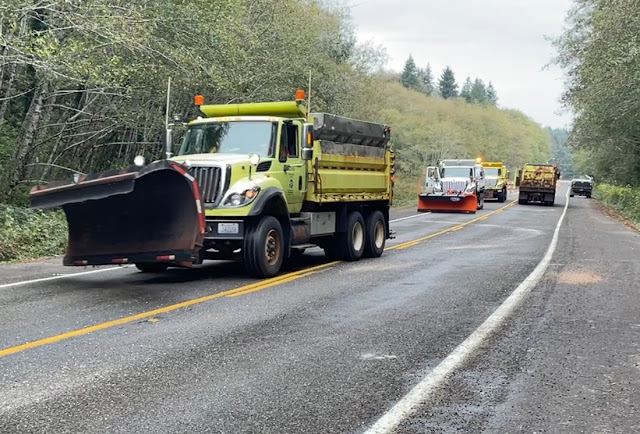

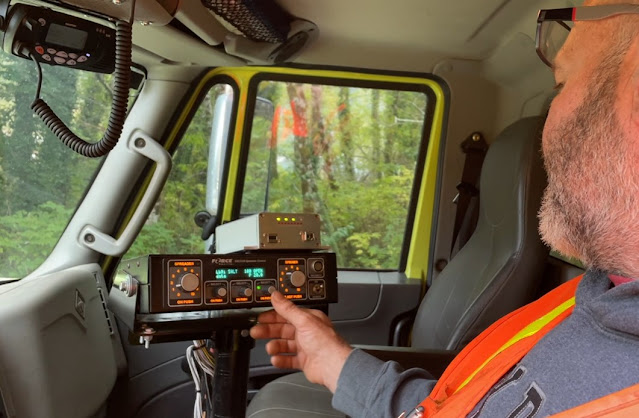
No comments:
WSDOT comment policy
Post a Comment